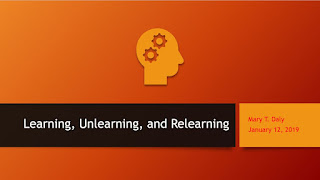Learning theories are the backbone of effective teaching. Having a learning theory helps teachers develop strategies and objectives that will guide them in facilitating student learning (Kivunja, 2014). Each teacher can combine parts of major learning theories such as cognitivism, constructivism, and social constructivism, and apply the resulting paradigm to their own students. My personal learning theory is that meaningful learning occurs when engagement, collaboration, and efficacy are all present. Without all three parts, learning is compromised, and teaching is therefore ineffective. The best way to achieve these three necessary parts is through technology.
The first facet, engagement, is necessary for meaningful learning because students thrive when immersed in learning (Laureate Education, 2015). According to Orey (Laureate Education, 2015), a commonality between the behaviorism, cognitivism, constructionism, and social constructivism is that the learner is active. Without the learner’s active engagement, meaningful learning does not result.
The second element vital to student learning is collaboration. According to the social constructivist theory, students learn best when they interact with each other (Beaumie, 2010). Students take on ownership and develop self-worth by working together (Beaumie, 2010). Richardson (2015) implores teachers to have students collaborate outside the confines of the school. Vygotsky, a proponent of social learning, would suggest students work with those they can model themselves after (Lever-Duffy & McDonald, 2015). Collaboration enriches a student’s learning experiences.
Priede and Vigule (2016) found that a student must feel that they have a “certain influence on the surrounding world” (p. 77). Students are motivated by having the power to affect situations they deem important. It is my belief that learning that lasts can be achieved when students are engaged, working in collaboration, and feeling empowered. I believe that all students can learn most effectively when all three characteristics of learning are combined.
In working towards my degree, specializing in educational technology integration, I have come to recognize the fundamental value of a technology-rich environment. Today’s students are tech-savvy, spending more time online than any before them. In 2015, 83% of children, age 3-18, used the internet at home, up from 2010 (NCES-National Center for Educational Statistics, 2017). Technology is part of almost every aspect of their experiences in the present world. Therefore, I believe it is essential to use technology to enhance learning and to give students the skills to learn with technology (International Society for Technology in Education (ISTE), 2018). Every year, I will continue to seek more ways to use technology to teach students meaningful content in a way that promotes student engagement, collaboration, and efficacy.
My students have been using technology on a regular basis in a myriad of ways, including leveled instruction and practice, research, word processing, and presentations. This year, my third graders will begin blogging and using a class Twitter account. In both experiences, students are engaged by authentic audiences and feedback to their posts (Richardson, 2015). Additionally, technology provides engagement through opportunities for local and global problem solving (Sulla, 2018). According to Petty (2018), the ability to collaborate with peers and experts across the world. Engagement can be attained with technology.
By next year, it is my plan that my students will digitally collaborate with partners at other schools across the United States and that they will reach out to experts for further information. Technology also affords students the ability to collaborate with classmates or to work asynchronously with people around the world. Digital choices exist that will help students reach goals with just right challenges, which can promote self-efficacy (Wang, 2010). My students regularly use technology to work on open-ended problem-based tasks where they seek ways to better the world, whether through writing, creating, giving, or researching.
All children can learn, and it is the teacher’s duty to prove this adage true for every student every year. An educator must create activities to facilitate learning, taking into account key differences including student readiness, culture, learning styles, interests and more (Laureate Education, 2016). Not accounting for these key individual factors will negate engagement because students will become frustrated. Collaboration cannot occur on an equal basis if students feel disrespected or academically inferior to their classmates. Students will not feel powerful if teachers see limitations instead of endless possibilities in all their students. It is the mission of Walden University (n.d.) to promote social change through the university community. I extend positive social change by creating a class environment based on understanding, where students respect each other and embrace differences.
Although “currently, there is no complete, perfect theory of education,” according to Henson (2010, p. 180), each educator must create one that feels right for them. My personal learning theory is that meaningful learning requires engagement, collaboration, and efficacy and is best achieved with the support of technology.
References:
Beaumie, K. (2010). Social constructivism. In Orey, M. (Ed.). Emerging perspectives on learning, teaching, and technology. Retrieved from http://textbookequity.org/Textbooks/Orey_Emergin_Perspectives_Learning.pdf
Henson, K.T. (2010). Curriculum planning: Integrating multiculturalism, constructivism, and education reform [Kindle edition]. Long Grove, IL: Waveland Press, Inc.
International Society for Technology in Education (ISTE). (2018). Standards for students. Retrieved from http://www.iste.org/standards/for-students
Kivunja, C. (2014). Do you want your students to be job-ready with 21st century skills? Change pedagogies: A pedagogical paradigm shift from Vygotskyian social constructivism to critical thinking, problem solving and Siemens' digital connectivism. International Journal Of Higher Education, 3(3), 81-91.
Laureate Education. (2016a). RWRCOEL Diversity Proficiencies. Retrieved from https://class.waldenu.edu
Lever-Duffy, J., & McDonald, J. (2015). Teaching and learning with technology (custom edition for Perdue University) [etextbook]. Boston, MA: Pearson Education.
NCES-National Center for Educational Statistics. (2017). Children’s access to and use of the internet. Retrieved from https://nces.ed.gov/programs/coe/indicator_cch.asp
Petty, B. (2018). Illuminate: Technology enhanced learning. San Diego, CA: EdTechTeam Press.
Richardson, W. (2015). From master teacher to master learner. Bloomington, IN: Solution Tree Press.


